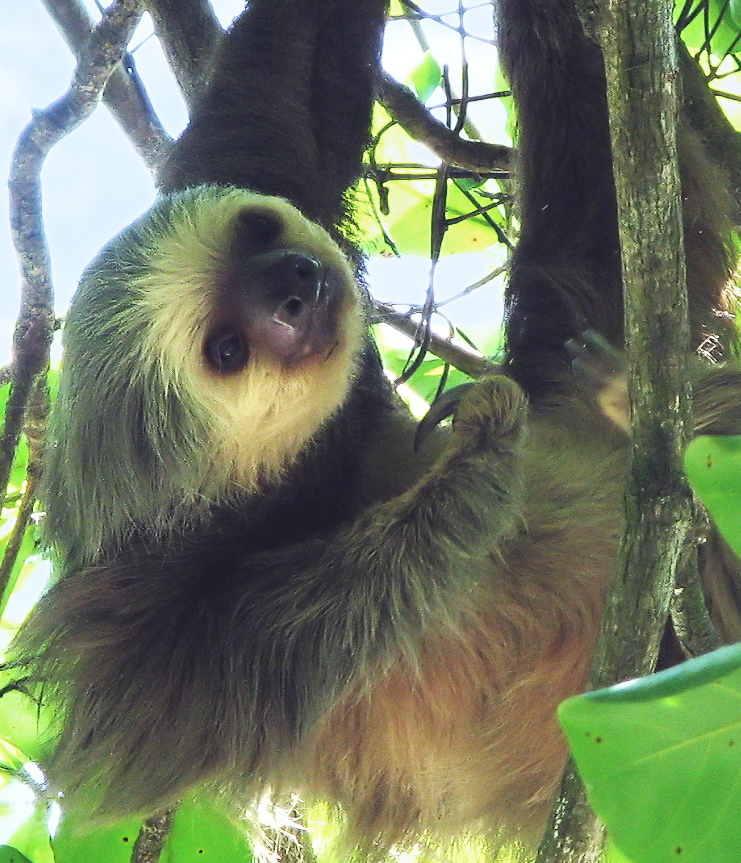- Hoffmann's Two-toed Sloth
Taxobox
name = Hoffmann's Two-toed SlothMSW3 Gardner|pages=101|id=11800019]
status = LC
status_system = iucn3.1
status_ref = IUCN2006|assessors=Meritt & members of the Edentate Specialist Group|year=2006|id=4778|title=Choloepus hoffmanni|downloaded=11 May 2006 Database entry includes justification for why this species is of least concern]
trend = unknown

image_caption = inManuel Antonio National Park ,Costa Rica
image_width = 250px
regnum =Animalia
phylum =Chordata
classis =Mammal ia
ordo =Pilosa
familia =Megalonychidae
genus = "Choloepus "
species = "C. hoffmanni"
binomial = "Choloepus hoffmanni"
binomial_authority = Peters, 1858The Hoffmann's Two-toed Sloth, "Choloepus hoffmanni", is aspecies ofsloth from Central andSouth America , with the greatest concentration inPanama . It is a solitary nocturnal and arboreal animal, found in mature and secondary rainforests and deciduous forests. With their shaggy fur, huge claws, and deliberate movements, two-toed sloths are unlikely to be confused with any other animal. At 12 to 15 pounds and about two feet in length, these nocturnal animals are the perfect size for moving about in the treetops of their rainforest habitat.The name of this animal commemorates the German naturalist Karl Hoffmann.
Subspecies
*"
Choloepus hoffmanni capitalis ",J.A. Allen , 1913
*"Choloepus hoffmanni florenciae ",J.A. Allen , 1913
*"Choloepus hoffmanni juruanus ",Lönnberg , 1942
*"Choloepus hoffmanni pallescens ",Lönnberg , 1928
*"Choloepus hoffmanni hoffmanni ", Peters, 1858Range
Hoffmann's Two-toed Sloth is found in the rainforest canopy in Central and South America, from
Nicaragua south toBolivia , and fromPeru east toBrazil .Behaviour
Two-toed sloths spend most of their time in trees, though they may travel on the ground to move to a new tree, and are excellent swimmers. They are strictly nocturnal, moving slowly through the canopy after dark, munching on leaves. The name "sloth" means "lazy," but the slow movements of this animal are actually an adaptation for surviving on a low-energy diet of leaves. These sloths have half the metabolic rate of a mammal of the same size. Sloths have very poor eyesight and hearing, and rely almost entirely on their senses of touch and smell to find food.
Two-toed sloths hang from tree branches, suspended by their huge, hook-like claws, which are two to three inches long. Sloths sometimes are found hanging off trees after they die. Nearly everything a sloth does, including eating, sleeping, mating, and giving birth, is done while hanging from the branches in the trees. The only time that sloths are normally found right side up is when they go down to the ground to defecate, which they only do about once every 5 days.
Sloths have many predators, including the
Jaguar ,eagle s, and largesnake s. If threatened, sloths can defend themselves by slashing out at a predator with their huge claws or biting with their sharp cheek teeth. However, a sloth's main defense is to avoid being attacked in the first place. The two-toed sloth can survive wounds that would be fatal to another mammal its size. The sloth's slow, deliberate movements and algae-covered fur make them difficult for predators to spot from a distance. Their treetop home is also out of reach for many larger predators. Their long, coarse fur also protects them from sun and rain. Their fur, unlike other mammals, flows from belly to top, not top to belly. This is so that when it rains, and they are hanging upside down, the rain slides off the fur easily.Over parts of its range, Hoffmann's Two-toed Sloth overlaps the range of the
Brown-throated Three-toed Sloth . Where this overlap occurs, the two-toed sloth tends to be larger and less numerous than its relative, showing less activity and being morenocturnal than the three-toed sloth. [citebook|title=The Encyclopedia of Mammals|editor=Macdonald, David|author=Dickman, Chris|year=1993|page=777]Life history
Female sloths may live in groups, while male sloths are usually solitary. In the wild, there are about 11 times more female two-toed sloths than male two-toed sloths. Female two-toed sloths give birth to a single offspring after an 11.5 month gestation period. The pup will nurse for at least 9 months, and may remain near its mother for more than 2 years. Two-toed sloths reach maturity at 4 to 5 years old.
Diet
Though two-toed sloths may occasionally eat fruits and flowers, nearly all of their diet is composed of tree leaves. They use their lips to tear off their food and chew with their peg-like teeth which have no enamel and are always growing. Like the unrelated
artiodactyl s, sloths have a multi-chambered stomach filled withsymbiotic bacteria to help them digest thecellulose in their fiber-rich diet. It may take a sloth up to a month to completely digest a meal, and up to two thirds of a sloth's weight may be due to the leaves in its digestive system.Conservation status
Habitat destruction is probably causing a decrease in the wild Hoffmann's Two-toed Sloth population, but there is little reliable data on the number of wild individuals. Sloths and people have little contact with one another in the wild.
References
* Louise H. Emmons and Francois Feer, 1997 - Neotropical Rainforest Mammals, A Field Guide.
Wikimedia Foundation. 2010.
